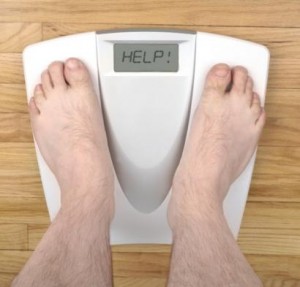A New Kind Of Diet For 2010
A New Kind Of Diet For 2010
 Last week when I stopped at the bank to deposit a check, I noticed a stack of free newspapers on a table next to the entrance doors. The newspapers were titled: Ladies First, Central Illinois Edition. I had never seen the Ladies First newspaper and was curious as to whether there were any attorneys who were advertising in it, so I picked one up and started paging through it.
Last week when I stopped at the bank to deposit a check, I noticed a stack of free newspapers on a table next to the entrance doors. The newspapers were titled: Ladies First, Central Illinois Edition. I had never seen the Ladies First newspaper and was curious as to whether there were any attorneys who were advertising in it, so I picked one up and started paging through it.
The newspaper was tabloid size (11” x 17”), consisted of 20 pages, and was printed in black and white, except for the first page which was printed in color. There were a lot more advertisers than I expected, and yes, there was one attorney who was advertising his services.
On pages 14 and 15 of the newspaper, there was what appeared to be full page article about a new weight loss product. I say “appeared” because I think the article was actually a paid advertisement, because there was no author attributed to the article (like the rest of the articles in the publication).
The article/ad included two sets of before-and-after pictures, with testimonials. The first set of pictures showed “Terry A-Peoria, IL,” a 63 year old woman who claimed she lost 50 pounds in 22 weeks. There was something very odd about Terry’s before-and-after pictures. It didn’t appear from the pictures that she had lost any weight. She was obviously obese and looked exactly the same in both pictures. I stared at both pictures in disbelief. One question that popped into my mind was: “Why did they use her pictures to advertise their weight loss product? She looks just as big in the second picture as she does in the first.”
I felt like I was looking at a set of those mind-game pictures where the artist makes six slight changes to the second picture and you’re suppose to find and circle the changes in the second picture. You know what I’m talking about don’t you? An example would be: Two pictures of a little boy standing outdoors next to a window. The second picture shows his shorts a little longer than what is shown in the first picture, there’s an extra branch on the tree in the second picture, etc.
So then I looked at the second set of before-and-after pictures which showed “Tom ‘the Truck Driver’ G-Glasford, IL.” The testimonial underneath the pictures said that Tom had lost 62 pounds in 25 weeks. It stated that he’s 50 years old and quoted Tom as saying, “but I feel like I’m 25 again!” (Yea, right Tom. That’s the perfect thing to say if you want to sell men on a product. Every man over the age of 40 would love to feel like he’s 25 again.)
The problem with the second picture of Tom was that he still looked like he was 50 and it appeared as though he lost, at most, 30 pounds – not the 62 pounds he was claiming.
I didn’t bother reading the article/ad. If those were the best pictures the weight loss company could come up with, I wasn’t about to waste my time reading about the product.
From 2002 to 2006, I worked with a well-known marketing consultant to assist me with the growth of my law firm. At one of our meetings, he told me that years ago he had written ads for Weight Watchers International. He said that there were two critical components to a successful weight loss ad: (1) color picture(s) of lots of delicious looking food, with at least one desert shown in the picture; and (2) color before-and-after pictures that show dramatic weight loss. To make an ad even better, he said that if pictures of a woman are shown, it helps significantly if she looks like a model in the “after” picture. If the ad shows pictures of a man, it helps significantly if he looks like an athlete in the “after” picture (with his shirt off so he can display his broad shoulders and washboard abs).
So here’s my first question for you: If you searched for and found a picture of yourself that was taken on January 1st of this year and matched it up against a picture that was taken yesterday, would there be a dramatic difference in the way you look? Would you look thinner, healthier, and firmer, or would you look fatter, flabbier, and fatigued.
Here’s my second question for you: If you were able to see the state of your soul as it was on January 1st of this year and matched it up against the state of your soul as it is right now, would there be a dramatic difference in the way your soul looks? Would it shine from the heroic virtues you developed during the past year, or would it be tainted by pride, anger, impurity, and/or some of the other vices?
While a lot of American Catholics will be starting diets next week hoping to achieve dramatic weight loss, most of those same Catholics won’t make any effort to figure out what they need to do to make dramatic strides toward perfection and sainthood.
As Catholics, we know that before our souls can ever make it into Heaven they must first be completely purified. If a person’s soul is destined for Heaven, but is not in a purified state at the time of death, that soul must first be cleansed and purified in purgatory before it can be welcomed into Heaven. Purgatory is like a spiritual boot camp that a soul must go through before it can get into Heaven.
Is your soul ready for Heaven right now?
Most of us actually have the mistaken belief that we’re in better shape than we really are. We’re like Terry A. of Peoria and Tom of Glasford – justifiably pleased with ourselves for our accomplishments, but pitifully short of the finish line.
So what can you do to get your soul in tip-top shape in 2010? You can start with following the two greatest commandments handed down to all of us by Jesus Christ: “Love God with all of your heart, mind, soul and body, and (2) love your neighbor as yourself.”
Yea, yea, I know, you’ve heard all of that before right? Well, it’s time to take our Lord’s commands seriously.
May I suggest that you develop a workout routine for your soul that includes a written plan that describes the frequency and manner by which you are going to make dramatic improvements in your love of God and neighbor during 2010? A good place to start would be to write down exactly how you are going to incorporate the spiritual and corporal works of mercy into your daily routine.
As a reminder, the corporal works of mercy are: (1) Feed the hungry; (2) Give drink to the thirsty; (3) Clothe the naked; (4) Shelter the homeless; (5) Visit the sick; (6) Visit the imprisoned; and (7) Bury the dead. The spiritual works of mercy are: (1) Instruct the ignorant; (2) Counsel the doubtful: (3) Admonish the sinner; (4) Bear wrongs patiently; (5) Forgive offenses willingly; (6) Comfort the sorrowful; and Pray for the living and the dead.
Do you think you’re capable of “bearing wrongs patiently” and “forgiving offenses willingly” every time you deal with another person? Over the course of a full year, that alone would provide a daily “workout” that would result in a dramatic improvement in the spiritual state of your soul.
Let me know a year from now how you did in 2010. I would like to see some real before-and-after results.



